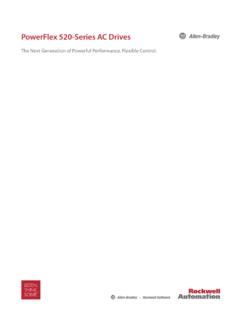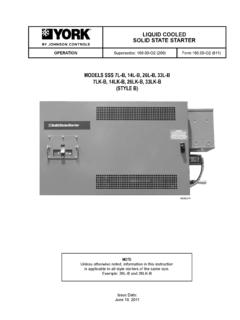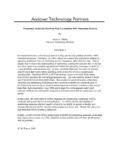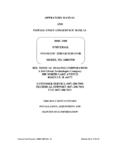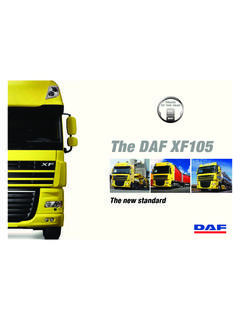Transcription of 1395 Digital DC Drive - Rockwell Automation
1 1395 Digital DC. Drive Troubleshooting Guide Important User Information Solid state equipment has operational characteristics differing from those of electromechanical equipment. Safety Guidelines for the Application, Installation and Maintenance of Solid State Controls (Publication available from your local Rockwell Automation Sales Office or online at ) describes some important differences between solid state equipment and hard-wired electromechanical devices. Because of this difference, and also because of the wide variety of uses for solid state equipment, all persons responsible for applying this equipment must satisfy themselves that each intended application of this equipment is acceptable.
2 In no event will Rockwell Automation , Inc. be responsible or liable for indirect or consequential damages resulting from the use or application of this equipment. The examples and diagrams in this manual are included solely for illustrative purposes. Because of the many variables and requirements associated with any particular installation, Rockwell Automation , Inc. cannot assume responsibility or liability for actual use based on the examples and diagrams. No patent liability is assumed by Rockwell Automation , Inc.
3 With respect to use of information, circuits, equipment, or software described in this manual. Reproduction of the contents of this manual, in whole or in part, without written permission of Rockwell Automation , Inc. is prohibited. Throughout this manual we use notes to make you aware of safety considerations. ATTENTION: Identifies information about practices or ! circumstances that can lead to personal injury or death, property damage, or economic loss. Attentions help you: identify a hazard avoid the hazard recognize the consequences Important: Identifies information that is especially important for successful application and understanding of the product.
4 Shock Hazard labels may be located on or inside the Drive to alert people that dangerous voltage may be present. Table of Contents Chapter 1 understanding the Basic Principles General .. 1-1. Required Equipment .. 1-1. ESD Sensitivity Precaution .. 1-2. Safety Facts to Read Before Proceeding .. 1-3. Chapter 2 Malfunctions with Indications General .. 2-1. Hard Faults .. 2-1. Soft Faults .. 2-2. Warning Faults .. 2-2. Fault Response Selection .. 2-2. Fault Setup Parameters .. 2-4. Fault Status Indicators .. 2-5. Bulletin 1300 Programming Terminal.
5 2-7. Fault Descriptions and Recovery .. 2-7. Fault Display on HHT or DHT .. 2-7. System Processor Faults (SP XX) .. 2-7. Velocity Processor (VP XX) .. 2-12. Current Processor Faults (CP XX) .. 2-22. Final Fault Recovery .. 2-32. Chapter 3 Malfunctions Not Indicated by a Fault General .. 3-1. Logic Control Malfunctions .. 3-1. Link/Configuration Parameter Malfunctions .. 3-3. Velocity Control Malfunctions .. 3-3. Velocity Feedback Device Malfunction .. 3-9. Encoder Device Malfunction.. 3-9. Analog Tachometer Malfunction.
6 3-13. Armature Current Control .. 3-15. Main Control Board Test Points .. 3-16. Field Current Control .. 3-19. Magnetics/Power Structure .. 3-22. Series A .. 3-22. Series B .. 3-29. Auto Tuning Malfunctions (Series A & B) .. 3-34. Chapter 4 Using Trending to Aid Troubleshooting General .. 4-1. Trend Programming .. 4-1. Examining Trend Data With a Program Terminal.. 4-3. Examining Trend Data with the Node Adapter.. 4-4. Examining Trend Data with the Discrete Adapter .. 4-4. Examples of Trends.. 4-4. System Considerations.
7 4-7. Ground Network Considerations.. 4-7. Electrical Noise Control .. 4-8. 2 Table of Contents Chapter 5 Manually Tuning the 1395 Drive Introduction .. 5-1. Tools & Test Equipment .. 5-1. Current Loop Tuning .. 5-1. Velocity Loop Tuning .. 5-3. Field Flux Tuning .. 5-4. Chapter 6 Test Points General.. 6-1. Main Control Board .. 6-1. Power Stage Interface/Switcher Board .. 6-3. Power Stage Interface Board .. 6-4. Power Supply Board .. 6-4. Appendix A Parameter List/Record General Checklist.. A-1. Drive Nameplate Data.
8 A-1. Wiring and Control Board Checks.. A-1. Measurement Record .. A-2. Parameter Record.. A-3. Index Chapter 1. understanding the Basic Principles General This guide is intended to help you define troubleshooting techniques and procedures and help simplify servicing of the Bulletin 1395 DC Drive by identifying likely causes for malfunction. The 1395 employs extensive diagnostics to aid in correcting many malfunctions that may occur in the system. This guide is designed to help interpret the diagnostic response of the Drive when a malfunction occurs.
9 It will also aid in diagnosing malfunctions that do not solicit a fault response from the Drive . Possible corrective measures will be explained to help get the Drive repaired or functional as quickly as possible for all types of malfunctions. ATTENTION: Only personnel familiar with the 1395 Drive ! System and the associated machinery should perform troubleshooting or maintenance functions on the Drive . Failure to comply may result in personal injury and/or equipment damage. Required Equipment In addition to a Bulletin 1300 Programming Terminal the following should be available before initiating any troubleshooting procedures: Digital Multimeter (DMM) capable of 1000 VDC/750 VAC, with a one megohm minimum input impedance.
10 Assorted screwdrivers (Phillips and Straight). Clamp on Ammeter (AC/DC) with current ratings to 3X rated armature current output of 1395 . Dual trace oscilloscope with differential capability, Digital storage, with two X10 and one X100 calibrated probes. (Optional but recommended.). Hand Tachometer used to monitor motor velocities. Bulletin 1395 Installation Manuals for: Programming Terminal (Bulletin 1300). Adapter Boards 1-2 understanding the Basic Principles ESD Sensitivity Precaution ATTENTION: This Drive may contain ESD (Electrostatic !)
